Legal System of Australia: Structure, Powers, and Processes
VerifiedAdded on 2021/04/21
|8
|1312
|43
Report
AI Summary
This report provides a comprehensive overview of the Australian legal system. It begins with an introduction to the legal system and its origins in British law, emphasizing the adversarial system. The report then delves into the Constitution of Australia, detailing its role as the primary legal document and outlining the division of constitutional powers between the Commonwealth and the states. It examines the structure of the Australian government, including the legislative, executive, and judiciary branches, with flowcharts illustrating the legislative process and the hierarchy of the High Court. The role of the Australian Parliament, comprising the House of Representatives and the Senate, is also discussed. The report concludes by summarizing the key aspects of the Australian legal system, highlighting its efficiency and the influence of British law.
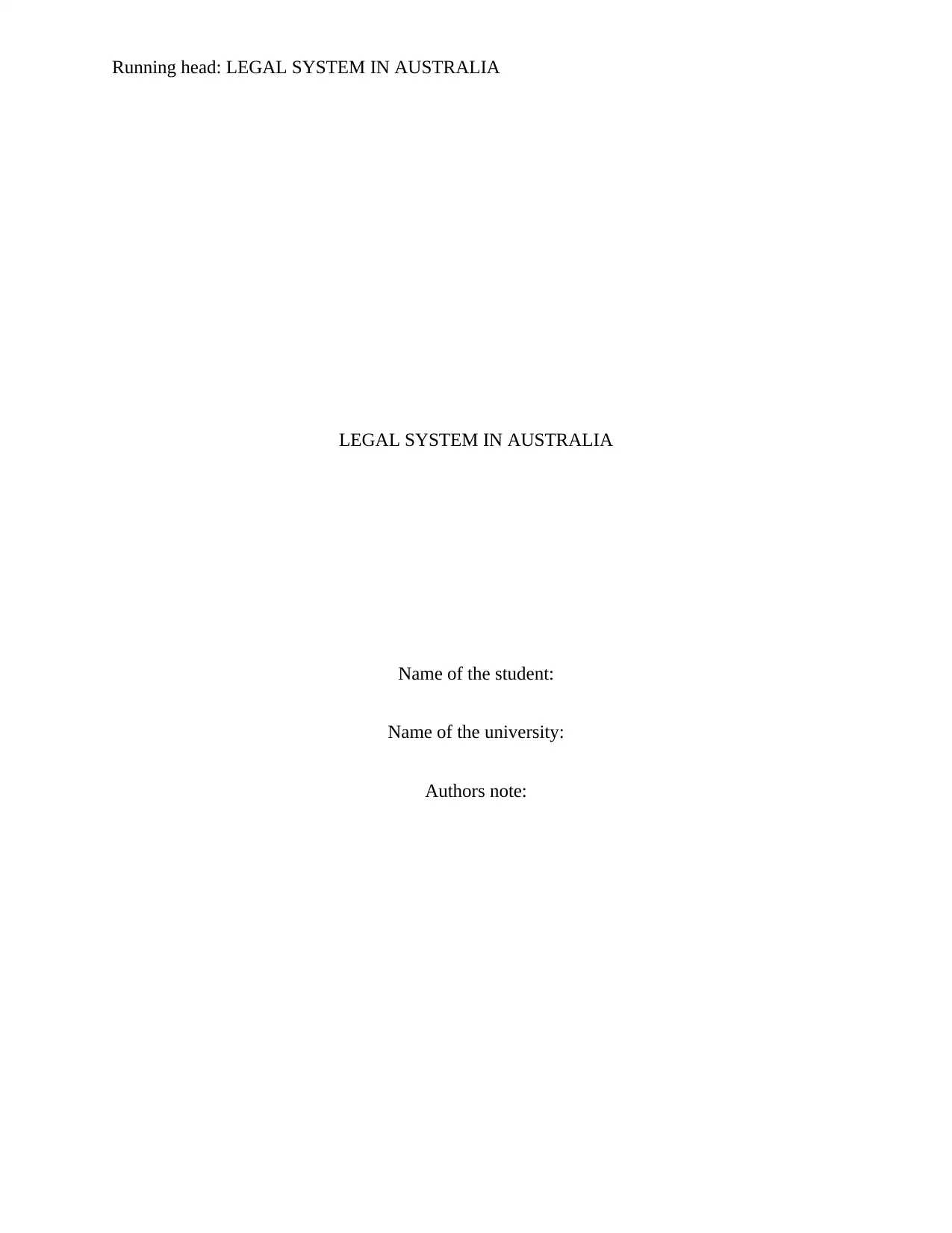
Running head: LEGAL SYSTEM IN AUSTRALIA
LEGAL SYSTEM IN AUSTRALIA
Name of the student:
Name of the university:
Authors note:
LEGAL SYSTEM IN AUSTRALIA
Name of the student:
Name of the university:
Authors note:
Paraphrase This Document
Need a fresh take? Get an instant paraphrase of this document with our AI Paraphraser
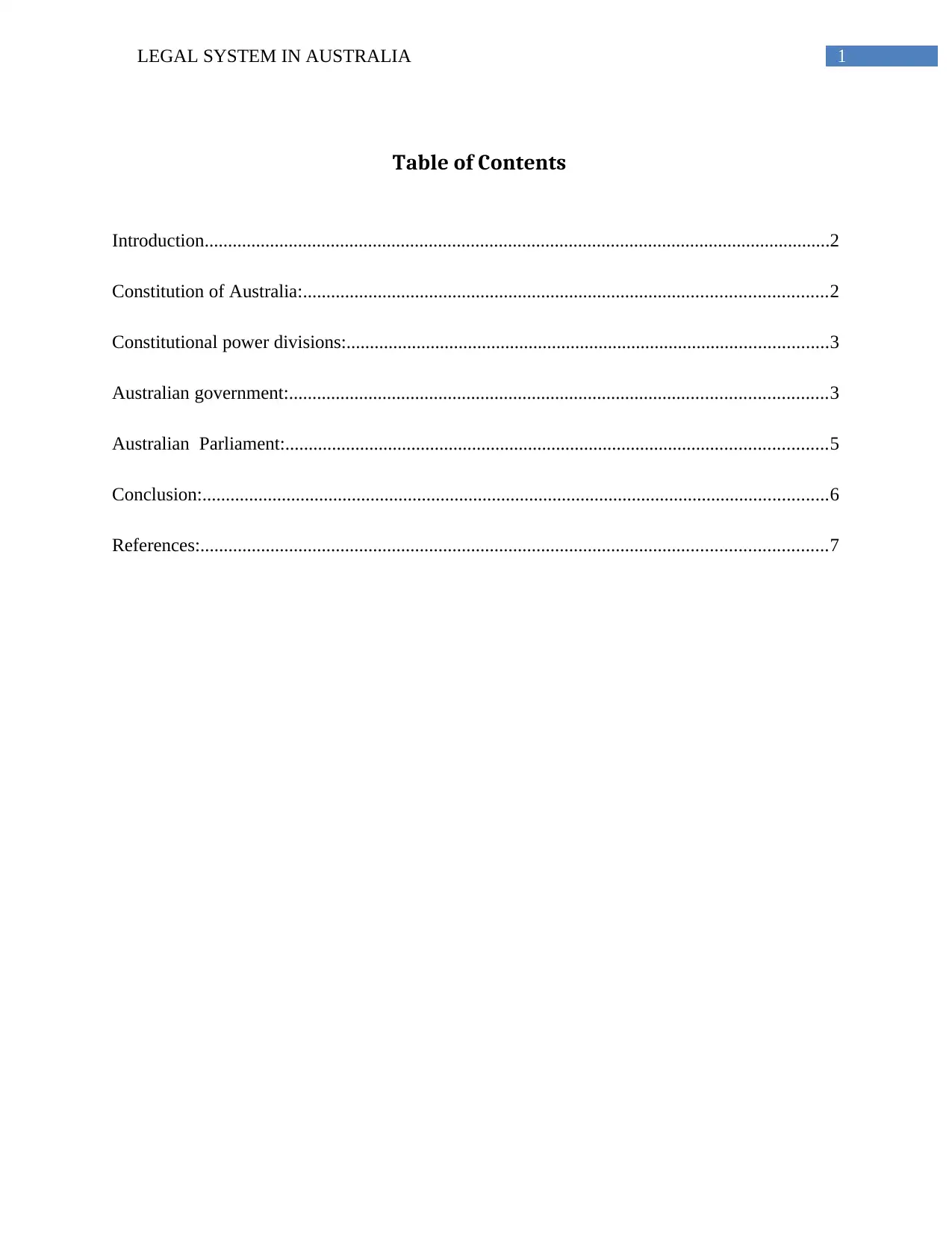
1LEGAL SYSTEM IN AUSTRALIA
Table of Contents
Introduction......................................................................................................................................2
Constitution of Australia:................................................................................................................2
Constitutional power divisions:.......................................................................................................3
Australian government:...................................................................................................................3
Australian Parliament:....................................................................................................................5
Conclusion:......................................................................................................................................6
References:......................................................................................................................................7
Table of Contents
Introduction......................................................................................................................................2
Constitution of Australia:................................................................................................................2
Constitutional power divisions:.......................................................................................................3
Australian government:...................................................................................................................3
Australian Parliament:....................................................................................................................5
Conclusion:......................................................................................................................................6
References:......................................................................................................................................7
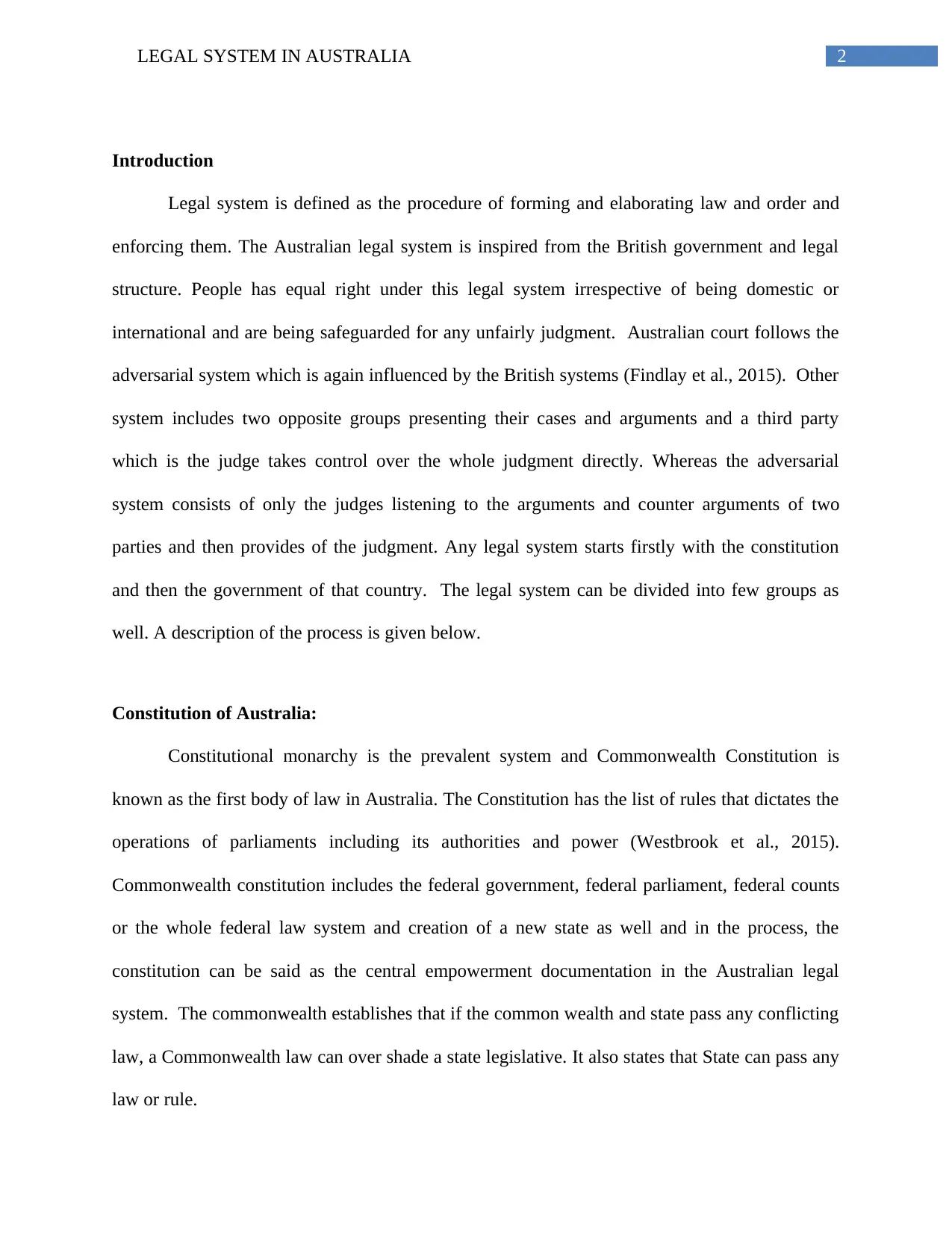
2LEGAL SYSTEM IN AUSTRALIA
Introduction
Legal system is defined as the procedure of forming and elaborating law and order and
enforcing them. The Australian legal system is inspired from the British government and legal
structure. People has equal right under this legal system irrespective of being domestic or
international and are being safeguarded for any unfairly judgment. Australian court follows the
adversarial system which is again influenced by the British systems (Findlay et al., 2015). Other
system includes two opposite groups presenting their cases and arguments and a third party
which is the judge takes control over the whole judgment directly. Whereas the adversarial
system consists of only the judges listening to the arguments and counter arguments of two
parties and then provides of the judgment. Any legal system starts firstly with the constitution
and then the government of that country. The legal system can be divided into few groups as
well. A description of the process is given below.
Constitution of Australia:
Constitutional monarchy is the prevalent system and Commonwealth Constitution is
known as the first body of law in Australia. The Constitution has the list of rules that dictates the
operations of parliaments including its authorities and power (Westbrook et al., 2015).
Commonwealth constitution includes the federal government, federal parliament, federal counts
or the whole federal law system and creation of a new state as well and in the process, the
constitution can be said as the central empowerment documentation in the Australian legal
system. The commonwealth establishes that if the common wealth and state pass any conflicting
law, a Commonwealth law can over shade a state legislative. It also states that State can pass any
law or rule.
Introduction
Legal system is defined as the procedure of forming and elaborating law and order and
enforcing them. The Australian legal system is inspired from the British government and legal
structure. People has equal right under this legal system irrespective of being domestic or
international and are being safeguarded for any unfairly judgment. Australian court follows the
adversarial system which is again influenced by the British systems (Findlay et al., 2015). Other
system includes two opposite groups presenting their cases and arguments and a third party
which is the judge takes control over the whole judgment directly. Whereas the adversarial
system consists of only the judges listening to the arguments and counter arguments of two
parties and then provides of the judgment. Any legal system starts firstly with the constitution
and then the government of that country. The legal system can be divided into few groups as
well. A description of the process is given below.
Constitution of Australia:
Constitutional monarchy is the prevalent system and Commonwealth Constitution is
known as the first body of law in Australia. The Constitution has the list of rules that dictates the
operations of parliaments including its authorities and power (Westbrook et al., 2015).
Commonwealth constitution includes the federal government, federal parliament, federal counts
or the whole federal law system and creation of a new state as well and in the process, the
constitution can be said as the central empowerment documentation in the Australian legal
system. The commonwealth establishes that if the common wealth and state pass any conflicting
law, a Commonwealth law can over shade a state legislative. It also states that State can pass any
law or rule.
⊘ This is a preview!⊘
Do you want full access?
Subscribe today to unlock all pages.

Trusted by 1+ million students worldwide
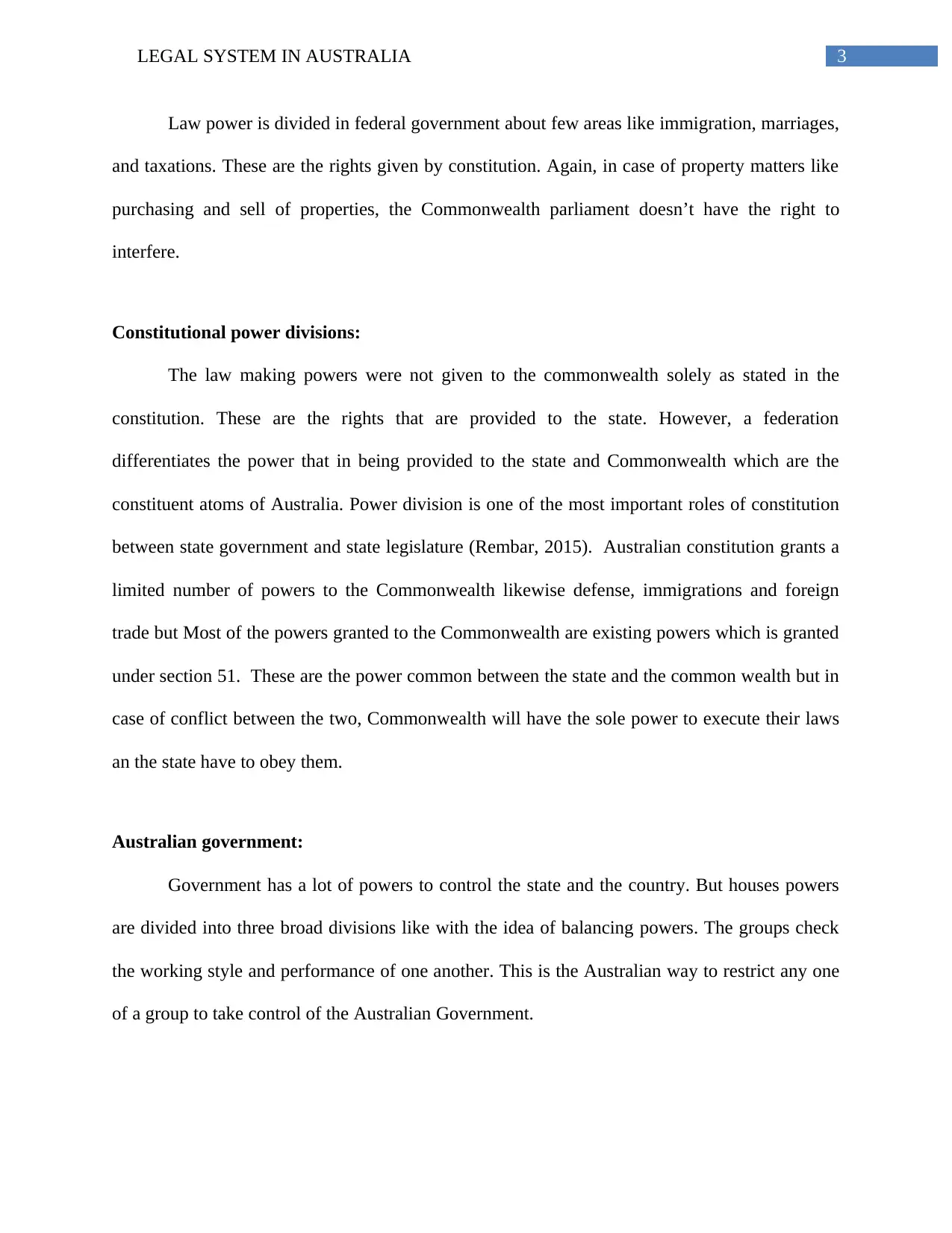
3LEGAL SYSTEM IN AUSTRALIA
Law power is divided in federal government about few areas like immigration, marriages,
and taxations. These are the rights given by constitution. Again, in case of property matters like
purchasing and sell of properties, the Commonwealth parliament doesn’t have the right to
interfere.
Constitutional power divisions:
The law making powers were not given to the commonwealth solely as stated in the
constitution. These are the rights that are provided to the state. However, a federation
differentiates the power that in being provided to the state and Commonwealth which are the
constituent atoms of Australia. Power division is one of the most important roles of constitution
between state government and state legislature (Rembar, 2015). Australian constitution grants a
limited number of powers to the Commonwealth likewise defense, immigrations and foreign
trade but Most of the powers granted to the Commonwealth are existing powers which is granted
under section 51. These are the power common between the state and the common wealth but in
case of conflict between the two, Commonwealth will have the sole power to execute their laws
an the state have to obey them.
Australian government:
Government has a lot of powers to control the state and the country. But houses powers
are divided into three broad divisions like with the idea of balancing powers. The groups check
the working style and performance of one another. This is the Australian way to restrict any one
of a group to take control of the Australian Government.
Law power is divided in federal government about few areas like immigration, marriages,
and taxations. These are the rights given by constitution. Again, in case of property matters like
purchasing and sell of properties, the Commonwealth parliament doesn’t have the right to
interfere.
Constitutional power divisions:
The law making powers were not given to the commonwealth solely as stated in the
constitution. These are the rights that are provided to the state. However, a federation
differentiates the power that in being provided to the state and Commonwealth which are the
constituent atoms of Australia. Power division is one of the most important roles of constitution
between state government and state legislature (Rembar, 2015). Australian constitution grants a
limited number of powers to the Commonwealth likewise defense, immigrations and foreign
trade but Most of the powers granted to the Commonwealth are existing powers which is granted
under section 51. These are the power common between the state and the common wealth but in
case of conflict between the two, Commonwealth will have the sole power to execute their laws
an the state have to obey them.
Australian government:
Government has a lot of powers to control the state and the country. But houses powers
are divided into three broad divisions like with the idea of balancing powers. The groups check
the working style and performance of one another. This is the Australian way to restrict any one
of a group to take control of the Australian Government.
Paraphrase This Document
Need a fresh take? Get an instant paraphrase of this document with our AI Paraphraser
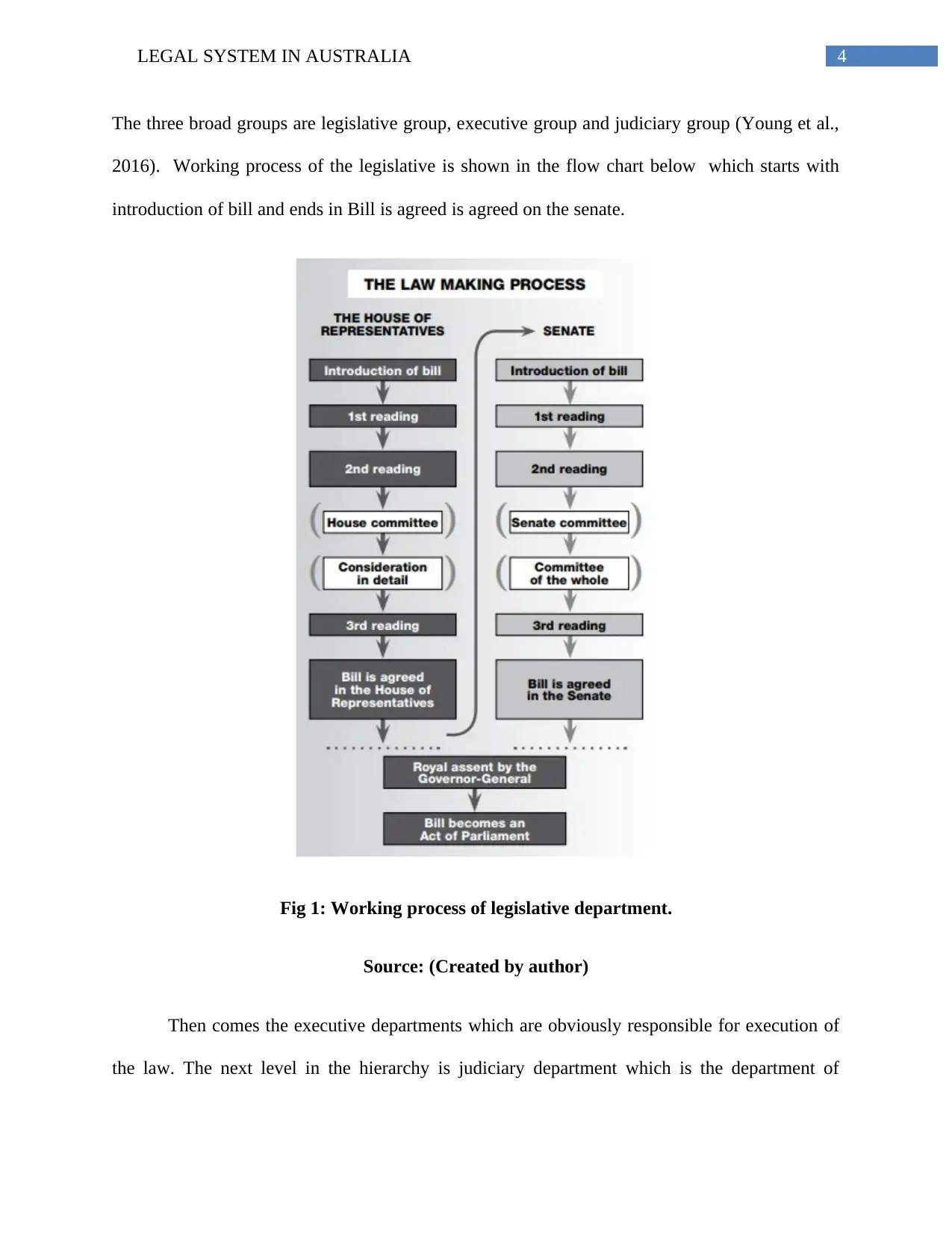
4LEGAL SYSTEM IN AUSTRALIA
The three broad groups are legislative group, executive group and judiciary group (Young et al.,
2016). Working process of the legislative is shown in the flow chart below which starts with
introduction of bill and ends in Bill is agreed is agreed on the senate.
Fig 1: Working process of legislative department.
Source: (Created by author)
Then comes the executive departments which are obviously responsible for execution of
the law. The next level in the hierarchy is judiciary department which is the department of
The three broad groups are legislative group, executive group and judiciary group (Young et al.,
2016). Working process of the legislative is shown in the flow chart below which starts with
introduction of bill and ends in Bill is agreed is agreed on the senate.
Fig 1: Working process of legislative department.
Source: (Created by author)
Then comes the executive departments which are obviously responsible for execution of
the law. The next level in the hierarchy is judiciary department which is the department of
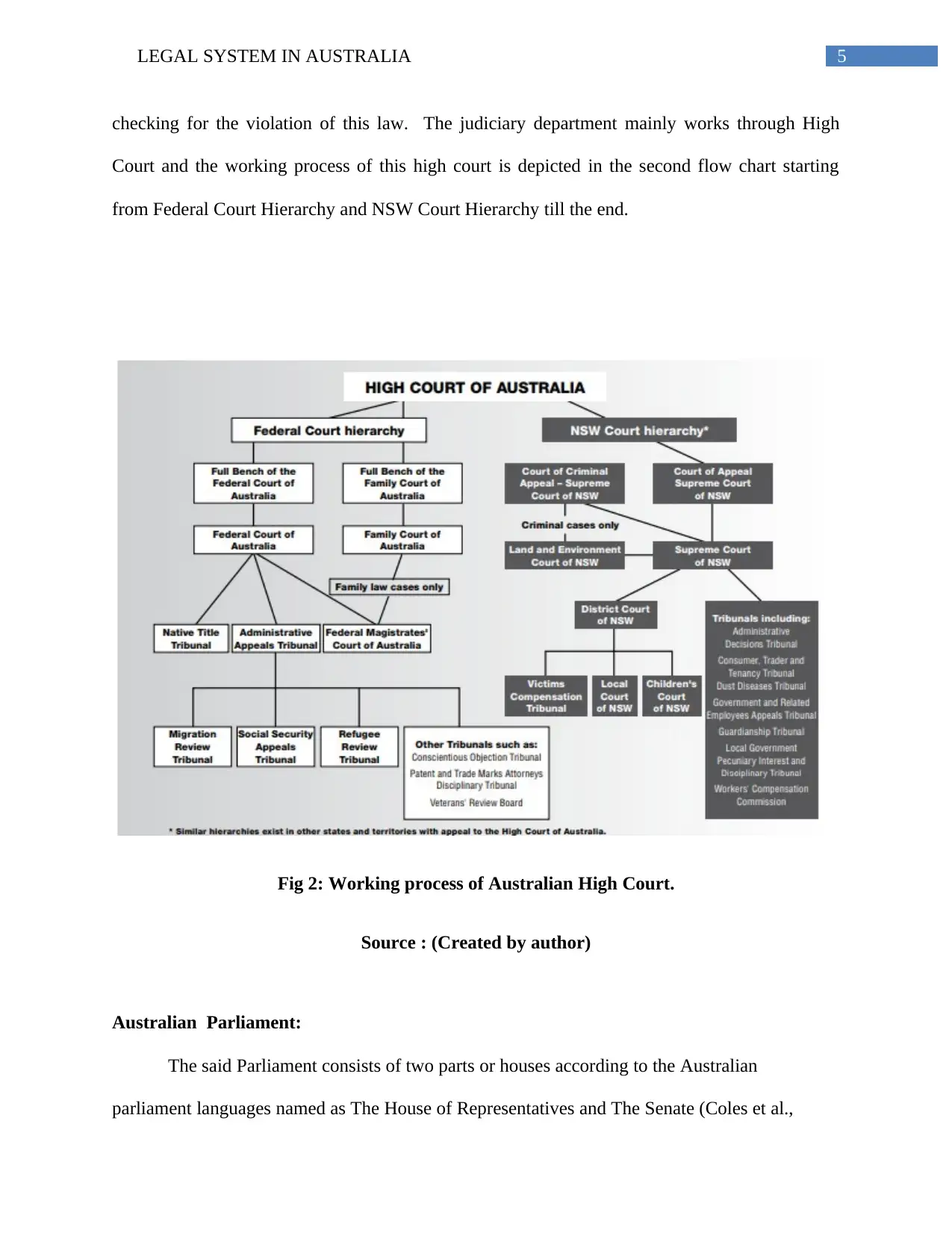
5LEGAL SYSTEM IN AUSTRALIA
checking for the violation of this law. The judiciary department mainly works through High
Court and the working process of this high court is depicted in the second flow chart starting
from Federal Court Hierarchy and NSW Court Hierarchy till the end.
Fig 2: Working process of Australian High Court.
Source : (Created by author)
Australian Parliament:
The said Parliament consists of two parts or houses according to the Australian
parliament languages named as The House of Representatives and The Senate (Coles et al.,
checking for the violation of this law. The judiciary department mainly works through High
Court and the working process of this high court is depicted in the second flow chart starting
from Federal Court Hierarchy and NSW Court Hierarchy till the end.
Fig 2: Working process of Australian High Court.
Source : (Created by author)
Australian Parliament:
The said Parliament consists of two parts or houses according to the Australian
parliament languages named as The House of Representatives and The Senate (Coles et al.,
⊘ This is a preview!⊘
Do you want full access?
Subscribe today to unlock all pages.

Trusted by 1+ million students worldwide
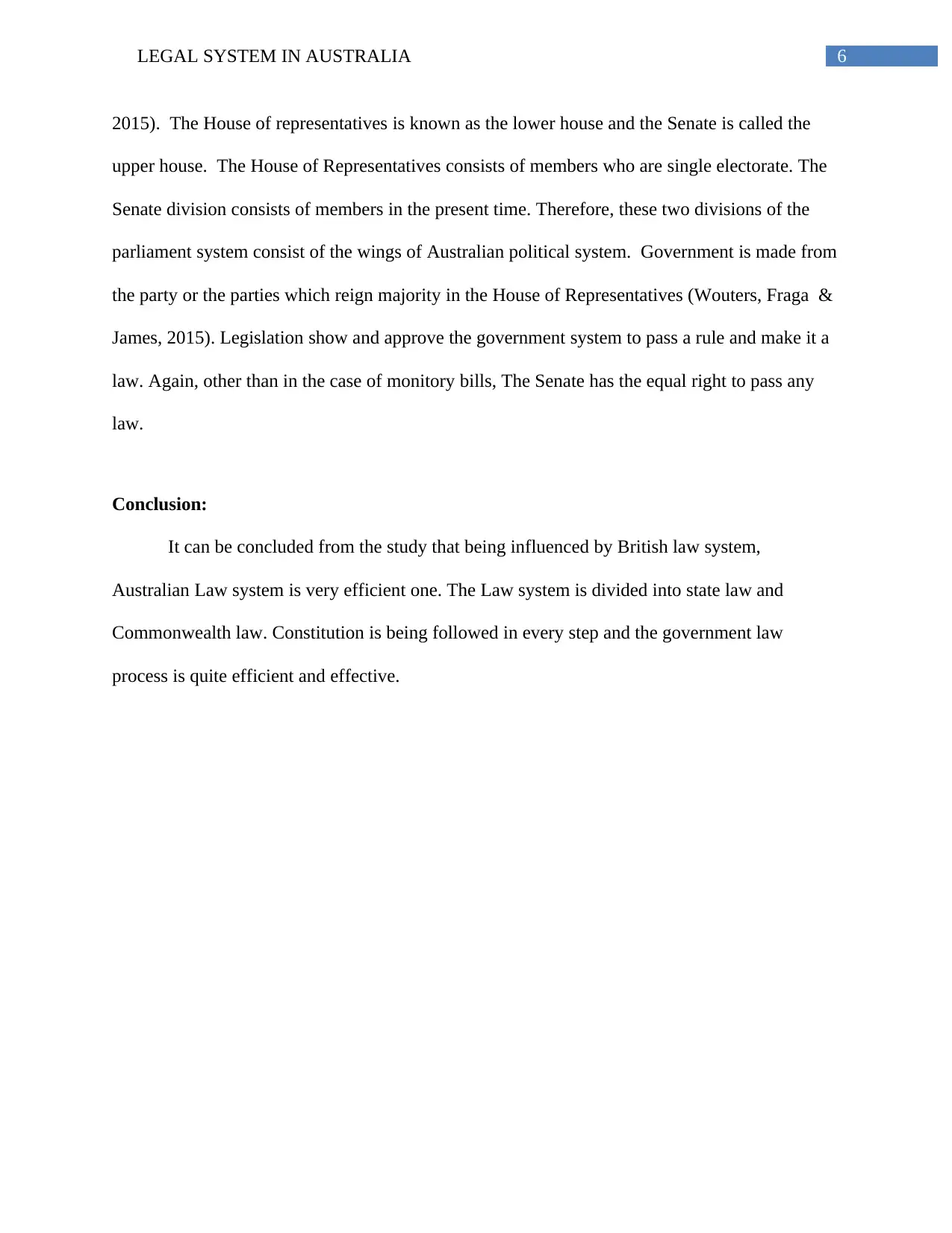
6LEGAL SYSTEM IN AUSTRALIA
2015). The House of representatives is known as the lower house and the Senate is called the
upper house. The House of Representatives consists of members who are single electorate. The
Senate division consists of members in the present time. Therefore, these two divisions of the
parliament system consist of the wings of Australian political system. Government is made from
the party or the parties which reign majority in the House of Representatives (Wouters, Fraga &
James, 2015). Legislation show and approve the government system to pass a rule and make it a
law. Again, other than in the case of monitory bills, The Senate has the equal right to pass any
law.
Conclusion:
It can be concluded from the study that being influenced by British law system,
Australian Law system is very efficient one. The Law system is divided into state law and
Commonwealth law. Constitution is being followed in every step and the government law
process is quite efficient and effective.
2015). The House of representatives is known as the lower house and the Senate is called the
upper house. The House of Representatives consists of members who are single electorate. The
Senate division consists of members in the present time. Therefore, these two divisions of the
parliament system consist of the wings of Australian political system. Government is made from
the party or the parties which reign majority in the House of Representatives (Wouters, Fraga &
James, 2015). Legislation show and approve the government system to pass a rule and make it a
law. Again, other than in the case of monitory bills, The Senate has the equal right to pass any
law.
Conclusion:
It can be concluded from the study that being influenced by British law system,
Australian Law system is very efficient one. The Law system is divided into state law and
Commonwealth law. Constitution is being followed in every step and the government law
process is quite efficient and effective.
Paraphrase This Document
Need a fresh take? Get an instant paraphrase of this document with our AI Paraphraser
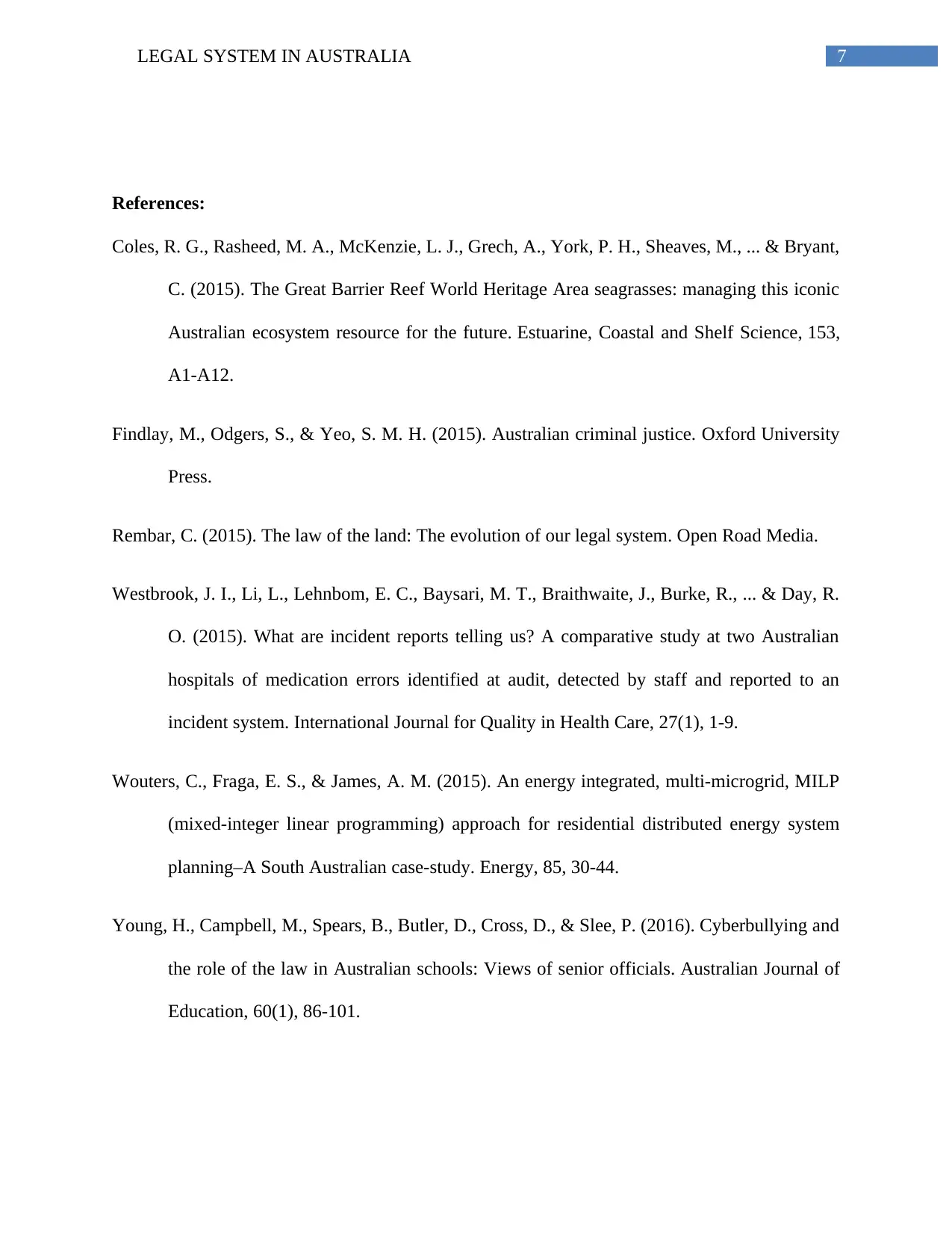
7LEGAL SYSTEM IN AUSTRALIA
References:
Coles, R. G., Rasheed, M. A., McKenzie, L. J., Grech, A., York, P. H., Sheaves, M., ... & Bryant,
C. (2015). The Great Barrier Reef World Heritage Area seagrasses: managing this iconic
Australian ecosystem resource for the future. Estuarine, Coastal and Shelf Science, 153,
A1-A12.
Findlay, M., Odgers, S., & Yeo, S. M. H. (2015). Australian criminal justice. Oxford University
Press.
Rembar, C. (2015). The law of the land: The evolution of our legal system. Open Road Media.
Westbrook, J. I., Li, L., Lehnbom, E. C., Baysari, M. T., Braithwaite, J., Burke, R., ... & Day, R.
O. (2015). What are incident reports telling us? A comparative study at two Australian
hospitals of medication errors identified at audit, detected by staff and reported to an
incident system. International Journal for Quality in Health Care, 27(1), 1-9.
Wouters, C., Fraga, E. S., & James, A. M. (2015). An energy integrated, multi-microgrid, MILP
(mixed-integer linear programming) approach for residential distributed energy system
planning–A South Australian case-study. Energy, 85, 30-44.
Young, H., Campbell, M., Spears, B., Butler, D., Cross, D., & Slee, P. (2016). Cyberbullying and
the role of the law in Australian schools: Views of senior officials. Australian Journal of
Education, 60(1), 86-101.
References:
Coles, R. G., Rasheed, M. A., McKenzie, L. J., Grech, A., York, P. H., Sheaves, M., ... & Bryant,
C. (2015). The Great Barrier Reef World Heritage Area seagrasses: managing this iconic
Australian ecosystem resource for the future. Estuarine, Coastal and Shelf Science, 153,
A1-A12.
Findlay, M., Odgers, S., & Yeo, S. M. H. (2015). Australian criminal justice. Oxford University
Press.
Rembar, C. (2015). The law of the land: The evolution of our legal system. Open Road Media.
Westbrook, J. I., Li, L., Lehnbom, E. C., Baysari, M. T., Braithwaite, J., Burke, R., ... & Day, R.
O. (2015). What are incident reports telling us? A comparative study at two Australian
hospitals of medication errors identified at audit, detected by staff and reported to an
incident system. International Journal for Quality in Health Care, 27(1), 1-9.
Wouters, C., Fraga, E. S., & James, A. M. (2015). An energy integrated, multi-microgrid, MILP
(mixed-integer linear programming) approach for residential distributed energy system
planning–A South Australian case-study. Energy, 85, 30-44.
Young, H., Campbell, M., Spears, B., Butler, D., Cross, D., & Slee, P. (2016). Cyberbullying and
the role of the law in Australian schools: Views of senior officials. Australian Journal of
Education, 60(1), 86-101.
1 out of 8
Related Documents
Your All-in-One AI-Powered Toolkit for Academic Success.
+13062052269
info@desklib.com
Available 24*7 on WhatsApp / Email
![[object Object]](/_next/static/media/star-bottom.7253800d.svg)
Unlock your academic potential
Copyright © 2020–2025 A2Z Services. All Rights Reserved. Developed and managed by ZUCOL.





